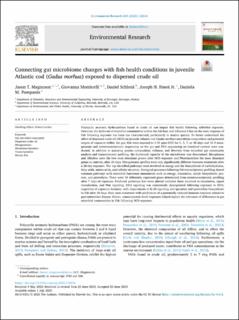| dc.contributor.author | Magnuson, Jason Tyler | |
| dc.contributor.author | Monticelli, Giovanna | |
| dc.contributor.author | Schlenk, Daniel | |
| dc.contributor.author | Bisesi, Joseph H. | |
| dc.contributor.author | Pampanin, Daniela Maria | |
| dc.date.accessioned | 2023-11-13T13:12:59Z | |
| dc.date.available | 2023-11-13T13:12:59Z | |
| dc.date.created | 2023-09-05T14:37:37Z | |
| dc.date.issued | 2023 | |
| dc.identifier.citation | Magnuson, J.T., Monticelli, G., Schlenk, D., Biesi, J.H. & Pampanin, D.M. (2023) Connecting gut microbiome changes with fish health conditions in juvenile Atlantic cod (Gadus morhua) exposed to dispersed crude oil. Environmental Research, 234 , 116516 | en_US |
| dc.identifier.issn | 0013-9351 | |
| dc.identifier.uri | https://hdl.handle.net/11250/3102195 | |
| dc.description.abstract | Polycyclic aromatic hydrocarbons found in crude oil can impair fish health following sublethal exposure. However, the dysbiosis of microbial communities within the fish host and influence it has on the toxic response of fish following exposure has been less characterized, particularly in marine species. To better understand the effect of dispersed crude oil (DCO) on juvenile Atlantic cod (Gadus morhua) microbiota composition and potential targets of exposure within the gut, fish were exposed to 0.05 ppm DCO for 1, 3, 7, or 28 days and 16 S metagenomic and metatranscriptomic sequencing on the gut and RNA sequencing on intestinal content were conducted. In addition to assessing species composition, richness, and diversity from microbial gut community analysis and transcriptomic profiling, the functional capacity of the microbiome was determined. Mycoplasma and Aliivibrio were the two most abundant genera after DCO exposure and Photobacterium the most abundant genus in controls, after 28 days. Metagenomic profiles were only significantly different between treatments after a 28-day exposure. The top identified pathways were involved in energy and the biosynthesis of carbohydrates, fatty acids, amino acids, and cellular structure. Biological processes following fish transcriptomic profiling shared common pathways with microbial functional annotations such as energy, translation, amide biosynthetic process, and proteolysis. There were 58 differently expressed genes determined from metatranscriptomic profiling after 7 days of exposure. Predicted pathways that were altered included those involved in translation, signal transduction, and Wnt signaling. EIF2 signaling was consistently dysregulated following exposure to DCO, regardless of exposure duration, with impairments in IL-22 signaling and spermine and spermidine biosynthesis in fish after 28 days. Data were consistent with predictions of a potentially reduced immune response related to gastrointestinal disease. Herein, transcriptomic-level responses helped explain the relevance of differences in gut microbial communities in fish following DCO exposure. | en_US |
| dc.language.iso | eng | en_US |
| dc.publisher | Elsevier Ltd. | en_US |
| dc.rights | Navngivelse 4.0 Internasjonal | * |
| dc.rights.uri | http://creativecommons.org/licenses/by/4.0/deed.no | * |
| dc.subject | torsk | en_US |
| dc.subject | fiskehelse | en_US |
| dc.subject | råolje | en_US |
| dc.subject | forurensing med råolje | en_US |
| dc.title | Connecting gut microbiome changes with fish health conditions in juvenile Atlantic cod (Gadus morhua) exposed to dispersed crude oil | en_US |
| dc.type | Peer reviewed | en_US |
| dc.type | Journal article | en_US |
| dc.description.version | publishedVersion | en_US |
| dc.rights.holder | © 2023 The Authors. | en_US |
| dc.subject.nsi | VDP::Landbruks- og Fiskerifag: 900::Fiskerifag: 920 | en_US |
| dc.source.volume | 234 | en_US |
| dc.source.journal | Environmental Research | en_US |
| dc.identifier.doi | 10.1016/j.envres.2023.116516 | |
| dc.identifier.cristin | 2172610 | |
| dc.source.articlenumber | 116516 | en_US |
| cristin.ispublished | true | |
| cristin.fulltext | original | |
| cristin.qualitycode | 2 | |

